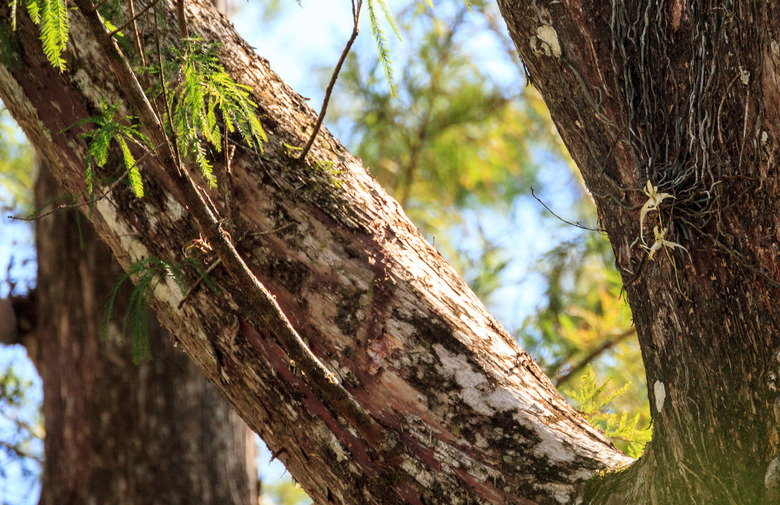How To Buy A Ghost Orchid
Orchids (family Orchidaceae) are incredible plants that produce stunning flowers with the proper care under the right conditions. There are common household orchid species that you can purchase at most nurseries or even your local grocery store, but one of the rarest orchid species is the ghost orchid (Dendrophylax lindenii, USDA zones 10-11). Often when something is deemed rare, people want to have one of their own by any means necessary, so you may be wondering whether it is possible to buy a ghost orchid.
Ghost Orchid Appearance
Ghost Orchid Appearance
What makes ghost orchids so spectacular is that they're leafless plants that are barely noticeable unless in bloom. When the blooms appear, they're usually snow-white, and since they have no leaves, the blooms appear to float in the air like ghosts. They're unique, stunning and definitely a sight to see.
Ghost Orchid Details
Ghost Orchid Details
Before committing to the idea of purchasing a ghost orchid, you need to know that harvesting one from the wild is illegal in order to preserve these delicate and rare plants. If you've found someone willing to sell you one, you should be aware that the "ghost orchid" in question is either a different species of orchid being passed off as a ghost orchid or you're engaging in a criminal activity by purchasing the plant.
Not only is purchasing one of these beauties illegal, but their survival rate when removed from their natural growing conditions is extremely low. They need very humid, marsh-like surroundings, which is where they're usually found when located in the wild. Their exact growing location isn't widely known, but according to National Geographic and a September 2019 article in Scientific Reports, their general location of growth is in the southern Florida swamp areas as well as Cuba.
It's highly discouraged to go searching for a ghost orchid in its natural habitats because of such dangers as wildlife lurking in the same areas. These areas are also under high supervision to try to prevent poachers from coming and ruining Mother Nature's beauty.
Ghost Orchid Care
Ghost Orchid Care
Owning a full-grown ghost orchid is extremely rare, and the only way to legally own a mature ghost orchid is to grow it from a seedling. Seedlings are available to purchase if you want to try your hand at growing them, but be warned that they're difficult to come by. Even with a seedling that has a healthy root system, there's no promise of success to the grower. OrchidWeb, a seller of ghost orchid seedlings, advises potential buyers that the ghost orchid is difficult and slow to grow so it requires patience to achieve success with this delicate plant.
If you manage to obtain a seedling from a reputable internet seller or orchid grower, you'll need to mist the orchid roots daily and provide moss and bark for the roots to attach to since in the wild, these plants may be found clinging to such host trees as pond apple (Annona glabra, zones 10-11), pop ash (Fraxinus caroliniana, zones 7-10) and Florida buttonwood (Conocarpus erectus, zones 10-11). They need high humidity and bright light from a window that faces east, south or west. Before diving into growing your own, you should definitely do your research first as these are very delicate plants that prefer growing under natural conditions.
Seedling Sellers and Requirements
Seedling Sellers and Requirements
There are a few places you can look online to potentially acquire this special orchid. For example, OrchidWeb, Native Exotics and Elite Orchids are all websites claiming to sell ghost orchid seedlings. While they may appear to be reputable sellers, you want to make sure you follow all the guidelines to legally bring the seedling into your home. If you do not follow the guidelines and make sure the necessary precautions are taken, your plant may be held up at customs due to missing paperwork.
You will likely need to apply for a permit to own and transport a rare exotic plant if the plant is being shipped from out of the country. You will also want to make sure that the seller has a phytosanitary certificate for the seedling, which is basically a passport for your plant. It has all the necessary information needed such as the identify of the grower, the plant's origins and its final destination. If this paperwork is in place, then you should not run into any problems as long as the seedling meets the import guidelines. You can verify with USDA Plant Permits and import information to make sure your information and paperwork are taken care of.
References
- Scientific Reports: Pollination Ecology of the Ghost Orchid (Dendrophylax lindenii): A First Description With New Hypotheses for Darwin's Orchids
- A Ghostly Pursuit: Developing a Passion for the Ghost Orchid
- OrchidWeb: Dendrophylax lindenii – 'The Ghost Orchid'
- National Geographic: Discovery Reveals Secrets About How Ghost Orchids Reproduce
- University of Florida IFAS Extension: Conocarpus erectus: Buttonwood
- USDA Animal and Plant Health Inspection Service: Plants and Plant Products Permits
